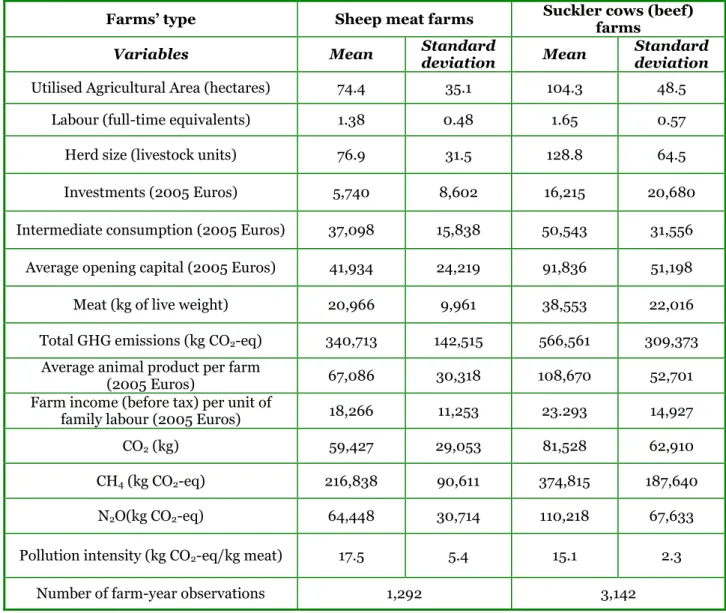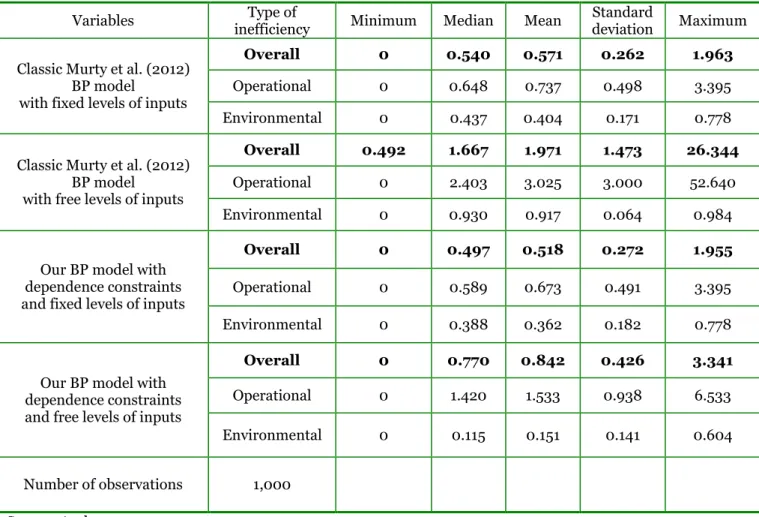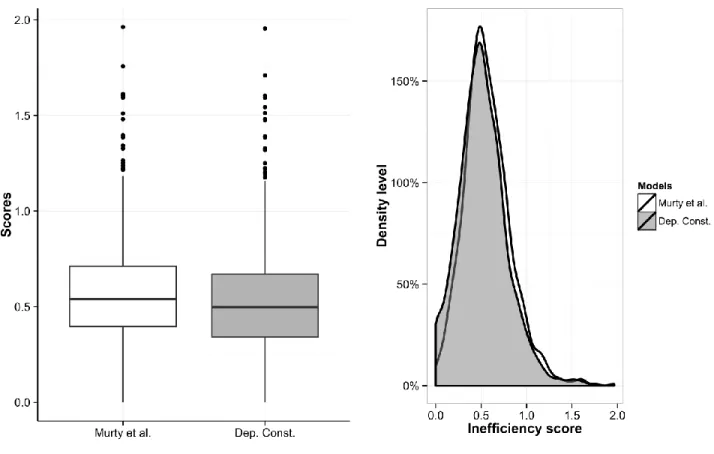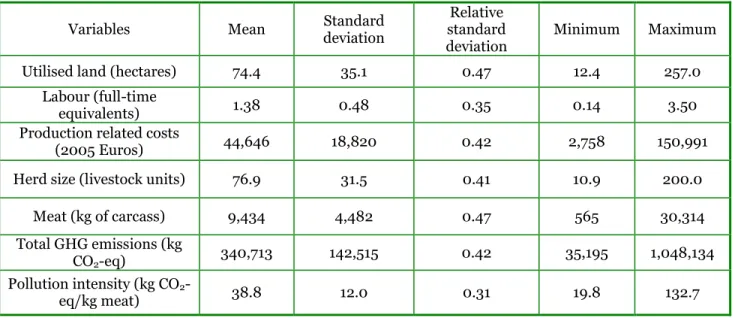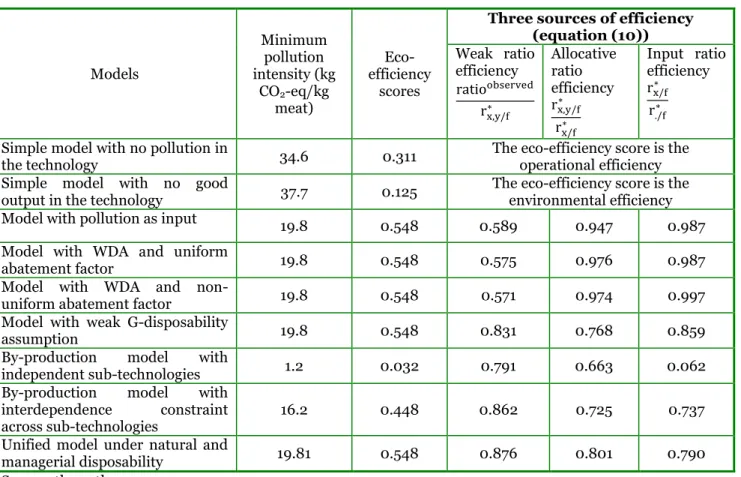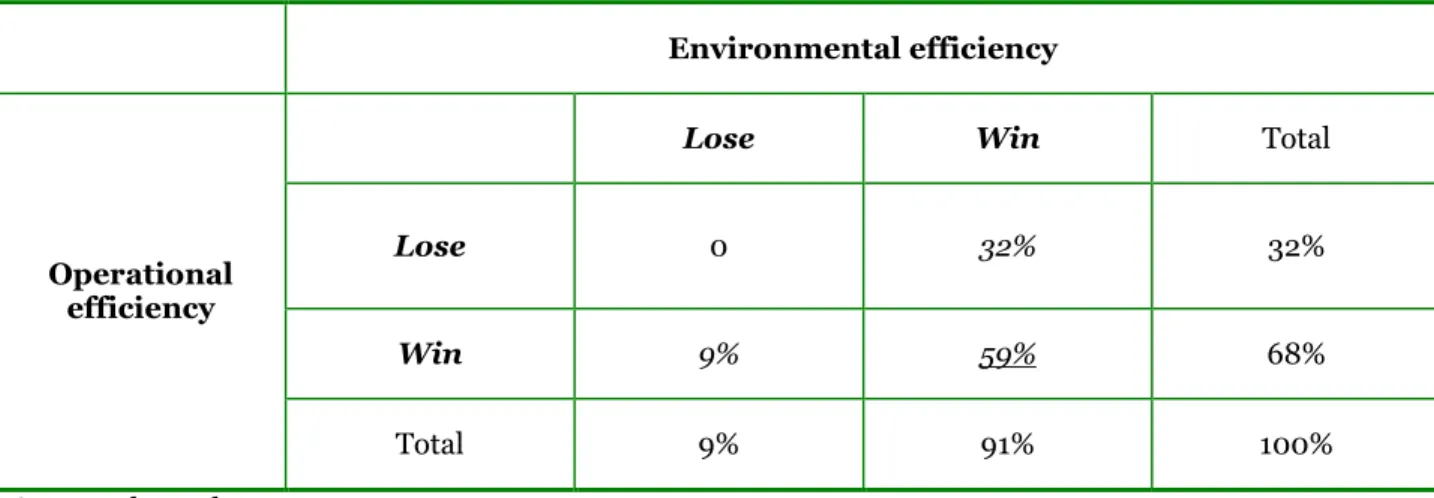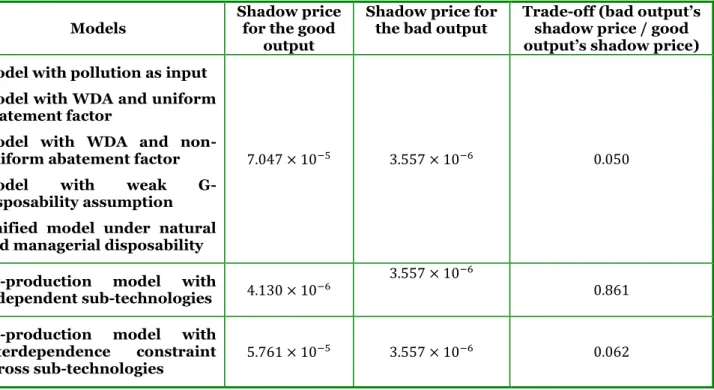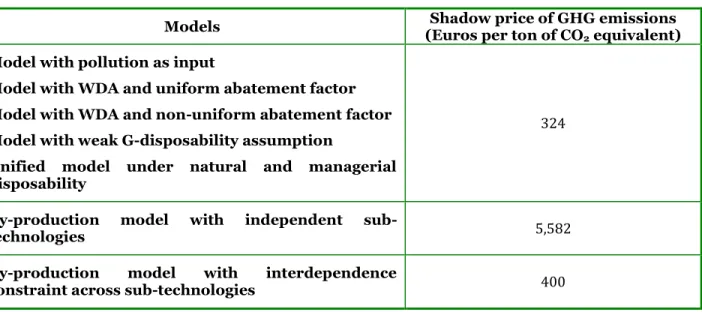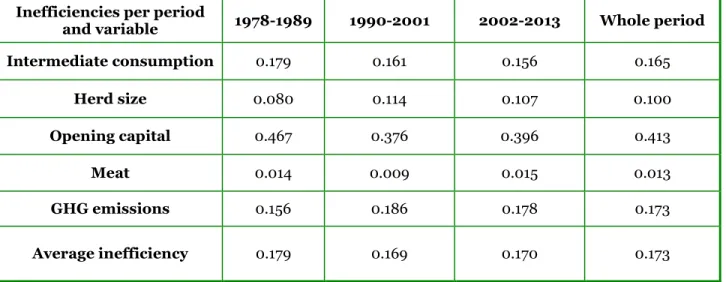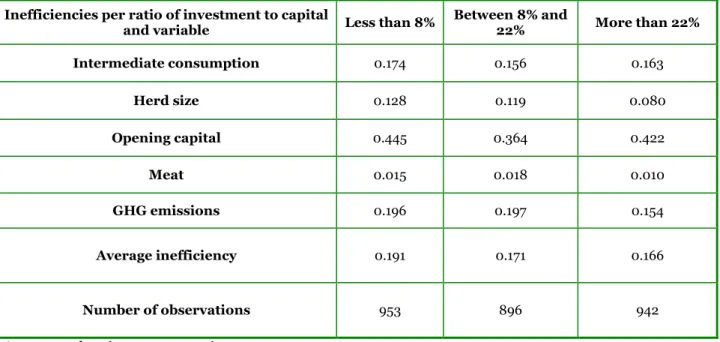HAL Id: tel-01266851
https://tel.archives-ouvertes.fr/tel-01266851
Submitted on 3 Feb 2016HAL is a multi-disciplinary open access archive for the deposit and dissemination of sci-entific research documents, whether they are pub-lished or not. The documents may come from teaching and research institutions in France or abroad, or from public or private research centers.
L’archive ouverte pluridisciplinaire HAL, est destinée au dépôt et à la diffusion de documents scientifiques de niveau recherche, publiés ou non, émanant des établissements d’enseignement et de recherche français ou étrangers, des laboratoires publics ou privés.
technologies : theoretical and methodological
considerations, with an application to the case of
greenhouse gas emissions in suckler breeding systems in
French grassland areas
K. Herve Dakpo
To cite this version:
K. Herve Dakpo. Non-parametric modelling of pollution-generating technologies : theoretical and methodological considerations, with an application to the case of greenhouse gas emissions in suckler breeding systems in French grassland areas. Economics and Finance. Université d’Auvergne -Clermont-Ferrand I, 2015. English. �NNT : 2015CLF10474�. �tel-01266851�
Ecole d’Economie - Université d’Auvergne - France
Ecole Doctorale des Sciences Economiques, Juridiques, Politiques et de Gestion Institut National de la Recherche Agronomique
Non-parametric modelling of pollution-generating technologies:
Theoretical and methodological considerations, with an
application to the case of greenhouse gas emissions in suckler
breeding systems in French grassland areas
Thèse Nouveau Régime
Présentée et soutenue publiquement le 15 Juin 2015
Pour l’obtention du titre de Docteur ès Sciences Economiques
Par
K Hervé DAKPO
sous la direction de Laure LATRUFFE et de Philippe JEANNEAUX
Members of the examining committee
Patrick PLANE Commitee President Professor, Université d'Auvergne, CERDI Charles Albert Knox
LOVELL Examiner Professor, School of Economics, University of Queensland Jean-Philippe
BOUSSEMART Examiner Professor, Université Charles de Gaulle – Lille 3, IESEG School of Management
Philippe POLOME Suffragan Professor, Université Lumière Lyon 2 GATE LES
Marc BENOIT Suffragan Research Engineer, INRA-UMR Herbivores
Laure LATRUFFE PhD Supervisor Researcher, INRA-UMR Smart
iii Ecole d’Economie - Université d’Auvergne - France
Ecole Doctorale des Sciences Economiques, Juridiques, Politiques et de Gestion Institut National de la Recherche Agronomique
Non-parametric modelling of pollution-generating technologies:
Theoretical and methodological considerations, with an
application to the case of greenhouse gas emissions in suckler
breeding systems in French grassland areas
Thèse Nouveau Régime
Présentée et soutenue publiquement le 15 Juin 2015
Pour l’obtention du titre de Docteur ès Sciences Economiques
Par
K Hervé DAKPO
v L’Université d’Auvergne n’entend donner aucune approbation ou improbation aux opinions émises dans cette thèse. Ces opinions doivent être considérées comme propres à l’auteur.
vii
Foreword
Almost four years ago when I graduated with my Master in Research in Economics of Development, I did not expect to end up in a PhD degree. This was without accounting for the seven month internship undertaken in the Livestock Farming Economics Laboratory (EGEE-UMRH) within the French National Institute of Agricultural Research (INRA) located in Clermont-Ferrand-Theix. During this internship I learnt how, with complex and sophisticated models, one can derive very practical implications especially in the area of agriculture. Within this environment I rubbed shoulders with different experts who somehow rekindled my flame of research interest. As a consequence I started a PhD position on the 3rd of September 2012. I would like to take advantage of those words to express my deep acknowledgement to all the people and institutions that have accompanied me all along those years, from the beginning of the internship to the completion of the PhD.
First, I am sincerely grateful to my two PhD supervisors Laure Latruffe (INRA, UMR SMART) and Philippe Jeanneaux (Vetagro Sup, UMR Métafort), who are the cement of this work. They spent a lot of time to educate me to research during this PhD. For their presence, their very active involvement, their listening and their understanding, I express my deep gratitude. I would also like to offer my thankfulness to all the members of the committee who followed my PhD research. Each year, through their comments and arguments, they pushed forward the realisation of this three-year work. Hence, I give my thanks to Catherine Araujo-Bonjean, Marc Benoit, Stéphane De Cara, Stéphane Ingrand, Claire Mosnier, and Philippe Polomé. A thank you also goes to all members of the PhD examining committee. I hope you will enjoy the reading of this manuscript.
I would like to give special thanks to all colleagues in the different labs that were involved in this PhD, namely EGEE (UMRH-INRA), Métafort (IRSTEA-VetAgro Sup), SMART (INRA-Agrocampus Ouest), and the Economics Doctoral School of Clermont-Ferrand University (ED245). Their patience, their availabilities when necessary and the numerous discussions that I had with them, largely contributed to forge all the opinions defended in this dissertation. I would like to take the opportunity of this foreword to highlight the hard work of data collection undertaken by the EGEE lab for many years now (the first farm surveys can be dated to 1971). These farm surveys provide a tremendous quantity of information that is useful for the empirical analysis conducted in this PhD, and they constitute an important resource for future collaboration. I am also grateful to all the aforementioned institutions for giving me access to all the bibliographic databases.
(the local government in the French region Auvergne) through a budgetary line called “Projets Structurants en Sciences Humaines et Sociales” (structuring projects in social and human sciences. In its desire to provide sufficient support to research in general, the “Conseil Regional d’Auvergne” has agreed to fund this PhD, and for this financial support that made the opportunity of a PhD concrete, I am truly grateful. I would also like to acknowledge Marc Benoit and Claire Mosnier who have defended the PhD project in front of a funding comity. My thanks also go also to Dominique Vollet, without whom we would have not heard about this funding. I am also grateful to the European project FLINT (“Farm Level Indicators for New Topics in policy evaluation”), in which the French team is managed by Laure Latruffe, for having funded several aspects of my PhD.
In July 2014 I attended a conference in Brisbane, Australia, namely the Asia-Pacific Productivity Conference (APPC), a specialised conference on productivity assessment. There I met Professor Knox Lovell (from School of Economics, University of Queensland, Australia) who gave me the opportunity to work with him for a few days after the conference. His valuable advices have helped to construct what is now Chapter 2 of this PhD dissertation. This encounter gave me confidence to express to other people my idea of this new model, and to go ahead alone with publication of the article. For this, I would like to express my huge gratitude to Professor Knox Lovell and hope that this is just the beginning of further collaboration. By the same occasion I thank Céline Nauges who was at this time in the University of Queensland, for her support when I was there. I would also take the opportunity of this foreword to thank Cyrille Rigolot and Ben Henderson with whom I spent some time at the CSIRO lab in Brisbane. I am also grateful to Amir Arjomandi, whom I met during the APPC, for giving me the opportunity to experience the developments carried out in this PhD with databases applied to other sectors than agriculture. This augurs for future research together.
Apart from travelling abroad to attend conferences, another interesting point while conducting my PhD was my research stay abroad. From September to the beginning of December 2014, I spent three months in Wageningen University in the Netherlands. The work I carried out there was supervised by Alfons Oude Lansink (Business Economics group of Wageningen University) and constitutes Chapter 4 of this PhD dissertation. I would like to give many thanks to Professor Alfons Oude Lansink for all the time he has devoted that was helpful for the accomplishment of this PhD. I have really enjoyed working with him, and this is just the beginning of a long collaboration. I would also like to thank all the colleagues and friends of the
ix Business Economics Group at Wageningen University. I am also grateful to the SMART (INRA) lab for funding this research stay and many other conferences and trips associated to the PhD.
I also offer great thanks to Professor Timo Sipiläinen (University of Helsinki) for his contribution which was determinant in completing Chapter 2 of the dissertation.
My first steps in Data Envelopment Analysis started from different meetings with David Berre, Jean-Philippe Boussemart and Hervé Leuleu. I would like to thank them for the inspiring discussions.
I would like to seize the opportunity that I have here to give my special thanks to Yann Desjeux (INRA, UMR SMART) for his support in the last days of writing this dissertation and his very useful advices. I am looking forward to collaborating with him on building a new package for R software to account for many of the developments realised during this PhD.
I would also like to underline that this PhD would have not been possible without the technical assistance of various people (administrative staff, IT support and library staff), in particular in EGEE and in SMART; many thanks to them.
The achievement of a PhD does not only require a good working environment, it also needs supportive family and friends. I want to all thank you personally for everything you have done, which gave me a balance in my life, a determining contribution for the completion of this PhD.
I also have a special thought to all farmers present in the databases that I used for the analysis. I hope that these new results can provide them useful information in their search for sustainability.
xi
Summary
The growing importance of environmental matters in social responsibility of firms has generated many frameworks of analysis in the economic literature. Among those frameworks, performance evaluation and benchmarking using the non-parametric Data Envelopment Analysis (DEA) have increased at a very fast rate. This PhD research focuses on models that include undesirable outputs such as pollution in the overall production system, to appraise eco-efficiency of decision making units (DMUs). Besides, the recent awareness on the large contribution of agriculture and particularly livestock farming to global warming, has highlighted for this sector the challenge of reaching both economic and environmental performances. In this line, the overall objective of this dissertation is to provide a theoretical and empirical background in modelling pollution-generating technologies and to suggest theoretical improvements that are consistent with the particular case of greenhouse gas emissions in extensive livestock systems. Firstly, we showed that all existing approaches that deal with undesirable outputs in the non-parametric analysis (i.e. DEA) have some strong drawbacks. However, the models grounded on the estimation of multiple independent sub-technologies offer interesting opportunities. Secondly, I developed a new framework that extends the by-production approach through the introduction of some explicit dependence constraints that link the sub-technologies in order to build a unified system. Thirdly, an empirical comparison, using a sample of French sheep meat farms, of this by-production modelling extension with the existing approaches, revealed some inconsistencies of these latter. Finally, we expanded this new by-production formulation to account for dynamic aspects related to the presence of adjustment costs. The application to the case of French suckler cow farms underlined the necessity of accounting for dynamic aspects and also showed high heterogeneity in investment strategies of these farmers.
Keywords: eco-efficiency, undesirable output, production technology, Data Envelopment Analysis, by-production, dependence constraints, factor bands, greenhouse gas, livestock farming.
xiii
Résumé
La prise en compte des problèmes environnementaux dans la responsabilité sociale des entreprises a généré en économie de nombreuses propositions. Parmi elles, le cadre d’analyse basé sur l’évaluation de la performance en utilisant notamment les techniques d’enveloppement des données (DEA) s’est très vite répandu dans la littérature théorique comme empirique. Ce travail de thèse s’inscrit dans cette logique en mettant l’accent sur la modélisation des technologies polluantes. Par ailleurs, la question des changements climatiques et de la forte contribution de l’agriculture et en particulier de l’élevage dans les émissions de gaz à effet de serre (GES) impose à ce secteur de relever aujourd’hui en plus du défi économique celui de l’amélioration de sa performance environnementale. L’objectif général de cette recherche doctorale est donc de fournir un nouveau cadre d’analyse théorique et empirique dans la modélisation des technologies polluantes afin d’évaluer l’éco-efficience des systèmes productifs, en particulier le cas des émissions de GES en élevage extensif de ruminants. Dans un premier temps, nous montrons les limites théoriques et méthodologiques des modèles existants. Néanmoins, nous insistons sur le fait que les approches basées sur l’estimation de plusieurs sous-technologies indépendantes pour prendre en compte les différents processus présents dans les systèmes productifs sont très prometteuses. Dès lors dans un deuxième temps, nous proposons une nouvelle extension de la méthode « by-production » qui repose sur l’introduction d’interconnections entre les différentes sous-technologies impliquées afin de construire un système plus unifié. Dans un troisième temps, une comparaison empirique utilisant des données d’exploitations de viande ovine de notre extension avec les approches existantes a révélé certaines incohérences de ces dernières. Enfin pour aller plus loin, nous élargissons dans un quatrième temps notre approche afin de prendre en compte les aspects dynamiques et notamment la présence de coûts d’ajustement. Les résultats de l’analyse empirique entreprise avec des données d’exploitations bovines allaitantes (viande) ont révélé la nécessité de prendre en compte ces aspects, mais ont aussi révélé la forte hétérogénéité existante dans les stratégies d’investissements des éleveurs.
Mots-clés: éco-efficience, production indésirable, technologie de production, méthode d’enveloppement des données (DEA), « by-production », contraintes de dépendance, « factor bands », gaz à effet de serre, élevage.
xv
Table of contents
Foreword ... vii Summary ... xi Résumé ... xiii Table of contents ... xv General Introduction ... 11. Background: Greenhouse Gas Emissions and livestock farming ... 2
1.1. Climate change, agriculture and livestock impacts ... 2
1.2. Sustainable development and theory of externalities ... 4
1.3. GHG mitigation alternatives in livestock farming and policy options ... 9
2. Problem statement, research questions and objective of the PhD ... 11
3. Livestock databases and GHG computations for the empirical applications ... 16
4. Structure of the dissertation ... 21
References ... 22
Chapter 1. Modelling pollution-generating technologies in performance benchmarking: Recent developments, limits and future prospects in the non-parametric framework ... 31
1. Introduction ... 32
2. Methodology for our literature review ... 37
3. The weak disposability assumption (WDA) ...38
3.1. Definition and operationalization ...38
3.2. Limits of the WDA ... 43
4. Recent developments in modelling pollution-generating technologies: materials balance approach and multiple frontier technologies ... 46
4.1. The weak-G disposability and the materials balance principles ... 46
4.2. By-production technologies... 49
4.3. Non-radial efficiency measure under natural and managerial disposability ... 54
5. Challenges and future trends of research ... 59
References ... 63
Chapter 2. On modelling pollution-generating technologies: a new formulation of the by-production approach ... 73
1. Introduction ... 74
2. The classic by-production modelling ... 77
4. A numerical application ... 92
5. Conclusion ... 95
References ... 97
Chapter 3. Greenhouse gas emissions and efficiency in French sheep meat farming: a comparison of pollution-generating technologies in non-parametric modelling ... 103
1. Introduction ... 104
2. The modelling of pollution-generating technologies in the literature ... 106
2.1. Different models available that include bad outputs in the production technology 106 2.2. Eco-efficiency assessment and decomposition, and shadow price computation 111 2.3. Empirical studies of efficiency and pollution-generating technologies in agriculture: a review of the literature ... 114
3. Data and methodology ... 116
3.1. Data... 116
3.2. Models implemented to assess eco-efficiency ... 118
4. Results ... 119
4.1. Eco-efficiency and its components ... 119
4.2. Trade-offs between operational efficiency and environmental efficiency ...121
4.3. Shadow prices ... 123
5. Conclusion ... 125
Annex: Applications of efficiency calculation accounting for bad outputs in agriculture128 References ... 132
Chapter 4. Investments and dynamic eco-efficiency under the by-production of undesirable output: a non-parametric framework ... 139
1. Introduction ... 140
2. Dynamic efficiency measurement in the literature ... 142
3. Dynamic aspects in pollution-generating technologies ... 145
4. Dynamic vs. static eco-efficiency estimation ... 149
5. Empirical application ... 151
6. Results ... 153
7. Conclusion ... 156
xvii
References ... 159
Chapter 5. General Discussion ... 165
1. Introduction ... 166
2. Environmental impacts’ analysis frameworks in the literature ... 166
3. Synthesis of main findings ... 170
4. Limits of the work ... 176
5. Suggestions for future research... 178
References ... 184
Conclusion ... 191
1. Background: Greenhouse Gas Emissions and livestock farming
1.1. Climate change, agriculture and livestock impacts
Global warming is one the greatest environmental challenges at the beginning of this twenty first century (Böhringer et al., 2002; Philp, 2012; Pittel et al., 2014). Climate change and its global warming effects raise the question of sustainable production behaviour for all sectors of human activity (food, water, health, economy, energy…). The expected consequences (droughts, floods, extreme climatic events…) of temperature increase on a global scale can be devastating in many regions (Stern, 2007; Schellnhuber et al., 2012; Schellnhuber et al., 2013). According to the Intergovernmental Panel on Climate Change (IPCC) “most of the observed increase in globally averaged temperatures since the mid-20th century is very likely due to the observed increase in anthropogenic greenhouse gas concentrations. The observed widespread warming of the atmosphere and ocean, together with ice mass loss, support the conclusion that it is very likely that it is not due to known natural causes alone” (Solomon et al., 2007). The recent increase in carbon dioxide (CO2) concentration in the atmosphere is attributed to anthropogenic activities.1
Agriculture is one of those activities. Agriculture-related negative externalities have raised social and political concerns (Guesmi and Serra, 2015). It has even been recommended in the Kyoto protocol the “promotion of sustainable forms of agriculture in light of climate change considerations” (United Nations, 1998). This situation has emphasised the debate around the multifunctionality of agriculture which generates simultaneously side-effects (by-products) along with food furniture (OECD, 2001). Actually, the farming sector, and especially the livestock sector, has been pointed out as one of the biggest contributor to air pollution through greenhouse gas (GHG) emissions (McAlpine et al., 2009; Steinfeld and Gerber, 2010; Herrero et al., 2011). Globally, accounting for direct and indirect impacts, agriculture represents 17% to 32%
1 It is worth saying that this vision of recent climate change and the contribution from human activities is
not shared by all (Capstick and Pidgeon, 2014). Some climate-sceptics question the scientific evidence of global warming, and others cast doubt on the relevance of climate policies to reduce greenhouse gas emissions. As argued in Pottier (2011) and Morel (2012), this climate-scepticism which relies on pseudo-scientific arguments to contest climate change, is rooted mainly on the uncertainties surrounding the expected consequences of climate change. According to these authors (Pottier, 2011; Morel, 2012) the non-believers of climate change actually reject the necessity of political actions to the extent that they finally deny the scientifically evident climate change.
General Introduction
3 of the total anthropogenic GHG emissions (Bellarby et al., 2008). 2 GHG emissions associated to agricultural activities are expected to increase by half by 2030 in light of the world future challenges (increase in the demand for food products, diet changes…) (Metz et al., 2007; Friel et al., 2009). The Food and Agriculture Organisation of the United Nations (FAO) has stressed that animal breeding is responsible for 13% to 18% of GHG emissions from human source (Steinfeld et al., 2006; Gerber et al., 2013). Red meat production, mainly beef, represents 41% of the GHG emissions associated to this sector (Gerber et al., 2013 pxii). For the United States’ Department of Agriculture (USDA), “GHG emissions from livestock are inherently tied to livestock population sizes because the livestock are either directly or indirectly the source for the emissions.” (USDA, 2004). This observation is linked to the increasing number of feedlots, which are highly intensive fattening systems, in the United States.3 The growing number of livestock in intensive production systems has explained the increase in GHG emissions (Paustian et al., 2006). In the same line Vergé et al. (2007) noted that “in recent years, industrial livestock production has grown at twice the rate of more traditional mixed farming systems and at more than six times the rate of production based on grazing”. The controversies surrounding livestock breeding and the consumption of red meat have increased recently, and this particularly since the publication of the FAO report “livestock’s long shadow” (Steinfeld et al., 2006; Dockès et al., 2012). Medias have relayed these controversies by publishing numerous slogans and headlines. For instance one can read at the head of the The Guardian published on July 21, 2014, that “Giving up beef will reduce carbon footprint more than cars, says expert”,4 or the screamer of the Time of December, 16 2013 which reads “The Triple Whopper Environmental Impact of Global Meat Production”.5
Three main GHGs are at stake namely methane (CH4), arising largely from enteric fermentation (associated to the normal digestive process of animals); nitrous oxide (N2O),
2 GHG are generated during various stages, from farming to food processing and distribution, and also
arise from waste management.
3 Website: http://www.epa.gov/agriculture/ag101/printbeef.html, consulted on April 21, 2015.
4
http://www.theguardian.com/environment/2014/jul/21/giving-up-beef-reduce-carbon-footprint-more-than-cars
5
http://science.time.com/2013/12/16/the-triple-whopper-environmental-impact-of-global-meat-production/. Other headlines can be read for example on http://www.bbc.com/news/science-environment-29007758, http://www.huffingtonpost.com/2014/07/21/beef-environmental-impact_n_5599370.html, http://www.natureworldnews.com/articles/10373/20141115/red-meat-contains-hidden-emissions.htm, http://www.theweek.co.uk/environment/60199/climate-change-why-meat-is-a-bigger-threat-than-cars.
related to nitrogen fertilisers and manure management; and CO2, associated to energy use resources (fossil fuels’ consumption, other agricultural inputs’ manufacturing, etc.). In Europe ruminant livestock systems account for about 9% of the total GHG emissions and 55% of the GHG associated to agriculture (Freibauer, 2003; Schils et al., 2007; Leip et al., 2010). In France, agriculture accounts for 19% of the national GHG emissions with a share of 53% attributed to animal breeding (Veysset et al., 2011).
It should however be stressed that livestock farming has various positive aspects for human kind. For example, in developing regions of the world, more than 752 million households derive their subsistence from livestock rearing which is an important sector to fight extreme poverty and food insecurity (Otte et al., 2012). In Europe and particularly in France, livestock systems for meat production are predominantly located in grassland disadvantaged areas (Veysset et al., 2013). The farms located in these areas experience the lowest revenue within the French farm population, and this is particularly true for the case of sheep meat producers (Veysset et al., 2014). This situation accentuates the dependency of those farms to European subsidies to live on (Veysset et al., 2005). This low profitability situation, together with the uncertainty around the future of the Common Agricultural Policy (CAP) reforms,6 and the tension on agricultural prices associated to trade openness with an increase competition, can explain the decrease in the number of meat producers. From another societal point of view, many of these farms located in mountain areas - where there are no other alternative activities than livestock rearing - help maintain the economic vitality of rural areas. In light of all these issues, the livestock sector in general, and specifically in France, faces the double challenge of economic and environmental sustainability.
1.2. Sustainable development and theory of externalities
In 1987 the United Nations World Commission on Environment and Development has stressed in its report titled “Our Common Future” (Brundtland, 1987 p43) that: “Sustainable development is development that meets the needs of the present without compromising the ability of future generations to meet their own needs. It contains within it two key concepts:
the concept of ‘needs’, in particular the essential needs of the world’s poor, to which overriding priority should be given; and
6 One can visit the following website for an overview of the CAP evolution in the last 50 years
General Introduction
5
the idea of limitations imposed by the state of technology and social organization on the environment’s ability to meet present and future needs.”
Clearly, the concepts of sustainability or sustainable development encompass three interconnected aspects of human life, namely economic and social capital development, and environmental protection.7 Often the concept is limited to the two pillars related to economics and environment. As such, many studies are grounded on the economics-ecology pair to define sustainability (Engel and Engel, 1990; Klaassen and Opschoor, 1991; Common and Perrings, 1992; Faucheux and O'Connor, 1998).
In the economic literature, environmental concerns are addressed on the basis of the concept of externalities (van den Bergh, 2010; Common, 2011). The origin of this concept can be dated to Alfred Marshall (1842-1924), and it has been fully introduced in the economic analysis by Henry Sidgwick (1838-1900) who first evoked the idea of external costs or benefits, later formalised by Arthur C. Pigou (1877-1959) in the case of market failures. Pigou (1920) initiated the integration of externalities into a partial static analysis framework and supported the idea that public intervention is a factor of efficiency. Welfare economics has thus focused on the processes of internalisation of externalities, which affect resource allocation and generate inefficiencies (Pigou, 1920; Pareto, 1971). More recently, a new formalisation has been proposed by Meade (1952), and the concept has been generalised with the definition of Buchanan and Stubblebine (1962) covering a broad spectrum of market failures from natural monopoly to common goods. According to these authors, the externality incurred by an individual B fundamentally depends on another individual A’s activities, that generated the externality and on which B has no control power, and also depends on the social group in which both individuals are operating. Externality then depicts situations where no financial compensation exists, and in general highlights the absence of control of the emitter by the receiver, a necessary condition for distinguishing real externalities (which require public intervention) from false ones (for which the receiver is totally indifferent). Thereafter, this definition has been restrained by Baumol and Oates (1975) who adopted the notion of real (non-monetary) effects. Mishan (1969) and Viner (1931) have proposed the term of technological externality.
The concept of externality can then be used to characterise environmental damages (which thus generate some external social costs) for which markets do not exist.8 According to
7 In some cases a fourth pillar may also be added, known as cultural diversity.
8 Sankar (2006) made a clear distinction between social costs (due to the presence of externalities) and
Heller and Starrett (1976) “all externality problems can be traced to some more fundamental problem having to do with market failure”. At different levels, regulations will play different role aiming at the internalisation of environmental damages. Several possibilities offered to policy-makers have been discussed in the literature (Pigou, 1920; Coase, 1960; Baumol and Oates, 1988). Among these possibilities are taxes or environmental standards, reduction of transactions costs, information on marginal abatement costs, good definition of property rights, etc.9 Environmental externalities generally meet the non-exclusivity and non-rivalry definitions of public goods.10 This situation prevents from an adequate definition of property rights. As stressed in Coase (1960), the absence of policy regulation will result in private costs lower than social ones, thereby creating over-use of public goods and loss in social welfare.11
At the international scale, the role of policy intervention to integrate environment in decision-making has been clearly stressed at the Earth Summit in Rio in 1992 through three major objectives (United Nations, 1992a):
markets for externalities: “(a) difficulty in defining, distributing and enforcing property rights and (b) high costs of creation and operation of markets.” According to Sankar (2006), “the theory of negative externality is the foundation of environmental economics.”
9 According to Coase (1960), “if transactions costs are zero and property rights are well defined, agents should be able to negotiate their way to an efficient outcome” (Varian, 2000 p292). However this situation, corresponding to the hypothesis of pure and perfect competition, is rare in practice. The point stressed by Coase, who never referred to the term “externality”, lays in the existence of transaction costs when confronting (defining) property rights. In terms of regulation, Coase’s theorem implies that given the levels of the transaction costs, possible actions are: i-) laissez-faire (let the market self-regulate); ii-) necessity of public intervention; and iii-) give the discretion power to a third party (specialist of law) who will allocate property rights to parties that best use them. Another solution to the problem of an externality is through the definition of a market for this externality (Arrow, 1970). “If a firm produces pollution that harms another firm then a competitive market for the right to pollute may allow for an efficient outcome” (Varian, 2000 p292). In this line Varian (1994) has designed some compensation mechanisms for internalising environmental impacts.
10 “A good is non-exclusive if it is impossible to exclude individuals from benefitting from the good. A good
is non-rival if one person’s consumption does not decrease the amount available to others” (Chakravarty, 2002 p678). Some environmental externalities like air or water pollution fit with these two properties. This implies that their monetary and as such are difficult to evaluate using the price system, and often consumers have not any options to not consuming those goods.
11 Hardin (1968) has referred to this situation in the presence of non-exclusive but rival good as the
General Introduction
7
“To incorporate environmental costs in the decisions of producers and consumers, to reverse the tendency to treat the environment as a ‘free good’ and to pass these costs on to other parts of society, other countries, or to future generations;
To move more fully towards integration of social and environmental costs into economic activities, so that prices will appropriately reflect the relative scarcity and total value of resources and contribute towards the prevention of environmental degradation;
To include, wherever appropriate, the use of market principles in the framing of economic instruments and policies to pursue sustainable development.”
The United Nations Framework Convention on Climate Change (UNFCCC) has since then been created, through its main organ the “Conference of the parties” (COP), a background for multilateral discussions between countries members, to set up actions against climate change and greenhouse gas emissions (GHG). Within this convention intergovernmental efforts are directed towards the objective of stabilising “greenhouse gas concentrations in the atmosphere at a level that would prevent dangerous anthropogenic interference with the climate system” (article 2) (United Nations, 1992b). As a consequence, countries members have committed to some binding benchmarks.
In summary, the main challenge is the internalisation of negative externalities and the design of policy tools to meet this objective. This challenge nowadays concerns GHG emissions. Solving the climate issue might require relevant actions at the international and local scales, but also at the firms and households’ levels. Besides, the global and domestic government interventions must account for the various spheres involved at each stage.
i-) The institutional dimension which delimits the political framework for the climate negotiations. Failure of these negotiations (Maltais, 2014) to adopt common rules in the short, middle and long run exposes the divergence of interest of the different parties (for instance the distribution of the costs and benefits of mitigating GHG), and this despite the warning of the scientific community. A relevant example is the Kyoto protocol signed initially by 38 countries in 1997 including the United States.12 Four years later, the lack of cooperation of the different parties in the design of the protocol left it non-ratified. More, the levels of GHG emissions of most countries have increased, and the American President Bush, after taking office, has stated
12 The protocol was about an agreement of the different countries to reduce within the period 2008-2012
the position of the United States to withdraw from the protocol (Böhringer et al., 2002).13 For developing countries, ratification of the Kyoto protocol by the United States is a sine qua non condition for the success for international policies for emissions control and adaptation strategies to the ineluctable change. Although the recent agreement between the United States and China (12 November 2014) which sets substantial cuts in their respective emissions, may facilitate future negotiations and overcome the inertia of the institutional system. Because of these institutional brakes,14 all existing agreements lack of enforcement mechanisms and thereby no one is forced to reduce polluting activities. Still in this institutional sphere, one can also find the direct regulations which define the political and legal considerations that govern for instance the market of innovation (patents), and the implied technical and structural changes, particularly their effect on firms competition.
ii-) The financial dimension, largely absent from the negotiation table. The financial crisis of 2008 has totally eclipsed the environmental negotiations and especially the conference of the parties (COP2009 in Copenhagen). The urgency needs created by this crisis have pushed into the background the environmental problem, as if environment had to wait for economic recovery. The speculative bubbles at the origin of this crisis have revealed the amount of money available on those markets and which could partly be redirected to fund GHG mitigation, e.g. by allocating them towards clean investments. Associating the financial dimension to the issues of global warming can certainly provide more effectiveness to climatic negotiations.
iii-) At the bottom of the institutional and financial dimensions we have in a more restrictive sense the productive sphere. The main actors in pollution generation are decision-making units, which use some resources with the objective to produce economic goods. The internalisation of non-economic goods like pollution by those units requires understanding the possible interactions between these two types of goods, and how the inclusion of the pollution in the units’ decisions might affect their overall profitability. The compliance of managers in mitigating their levels of pollution can be influenced by appropriate incentives that conform to the managers’ capitalist logic: for example, incentives that provide, when necessary, the right compensation. In other words, the support of the managers highly depends on the
13 Earlier, on July 25, 1997, the senate of the United States unanimously voted a resolution which explicitly
mentions that the United States should not be a signatory to any protocol that did not include binding targets and timetables for developing as well as industrialised nations, or this “would result in serious harm to the economy of the United States” (Cool, 2006).
14 One can also refer to the book of Goldstein and Pevehouse (2013 p4-9) where the authors discuss the
General Introduction
9 effectiveness of the mitigation actions. This is possible only if at a certain point policy-makers have sufficient information (knowledge), and a large choice of measures (indicators), on which they can ground the design of a targeted policy scheme. This PhD aims at contributing to the knowledge on how negative externalities can be internalised at a firm level, by relying on approaches that include bad outputs in performance assessment.
In the next sub-section we discuss the specific case of livestock systems and how to deal with the problem of GHG emissions in terms of policy and mitigation options.
1.3. GHG mitigation alternatives in livestock farming and policy options
The “Oxford Martin Programme on the Future of Food” has underlined that “the goal of sustainable intensification is to increase food production from existing farmland while minimising pressure on the environment. It is a response to the challenges of increasing demand for food from a growing global population, in a world where land, water, energy and other inputs are in short supply, overexploited and used unsustainably. Any efforts to ‘intensify’ food production must be matched by a concerted focus on making it ‘sustainable.’ Failing to do so will undermine our capacity to continue producing food in the future”.15 As defined, the concept of sustainable intensification implies the development of innovative and sustainable agricultural practices through adoption of new technologies or the enhancement of actual agricultural production systems (Ringler et al., 2014). In the same vein, the necessary transformations of agriculture have been summarised by the FAO in the concept of “climate-smart agriculture” (FAO, 2013).16
This new concept lays on three objectives: “firstly, increasing agricultural productivity to support increased incomes, food security and development; secondly, increasing adaptive capacity at multiple levels (from farm to nation); and thirdly, decreasing greenhouse gas emissions and increasing carbon sinks” (Campbell et al., 2014). These concepts of sustainable intensification and climate-smart agriculture stress that policies should provide the proper incentives for the adoption of mitigation strategies. In terms of GHG emissions mitigation, agriculture and in particular livestock farming are center sectors. Firstly, agriculture offers the advantage of reducing its own emissions but also the ones generated by other sectors; secondly
15 Website: http://www.futureoffood.ox.ac.uk/sustainable-intensification (consulted on 04-13-2015). See also
Garnett and Godfray (2012).
16 As pointed out in this report (FAO, 2013 p27) the concepts of sustainable intensification and
agriculture must face the double challenge of mitigation and adaptation, coined “feedback loop”17 in Raney et al. (2009); and thirdly, according to many experts, the livestock farming sector offers numerous cost effective solutions to the problem of climate change (Intergovernmental Panel on Climate Change - IPCC, 1990; McMichael et al., 2007). Among those solutions one can name sink practices, land management options (relating to grazing and pasture management, tillage reduction…), herd management alternatives, genetic improvement, fertilisers’ and other inputs’ management options. They have been largely discussed in the literature (Cole et al., 1997; Mosier et al., 1998; Oenema et al., 2001; Janzen et al., 2006; Burney et al., 2010). Further suggestions relate to the promotion of collective actions (OECD, 2013), changes in patterns of consumption (Garnett, 2011), payments for agri-environmental services (Legg, 2009).
Two main types of policy instruments have been proposed to promote environmental-friendly agriculture: market driven mechanisms (such as taxes, tradable permits), and command and control tools (such as pollution standards) (Cole and Grossman, 1999). Within the European Union (EU), a number of measures have been undertaken. For instance, in 1991 the nitrate directive has been introduced to lower nitrogen use in agriculture and prevent water pollution (European Council, 1991). In addition, the EU CAP has introduced with the MacSharry reform in 1992 some financial incentives based on agri-environmental schemes. Agri-environmental schemes, now sitting in the second pillar of the CAP (that is to say within the rural development framework), are tailored for each EU member state in order to reconcile the production of agricultural goods and the respect of the environment, by encouraging the adoption of sound environmental agricultural practices (Lenihan and Brasier, 2009). In addition, the cross compliance of the first CAP pillar links direct payments to some sustainability standards (Latacz ‐ Lohmann and Hodge, 2003). As pointed out in Canton et al. (2009) these policies, designed to compensate farms with incurred costs and forgone revenues, and also to encourage the switching from intensive to extensive systems, are subject to information asymmetry in their implementation. This situation creates distortions and can in turn affect the effectiveness of the policy.
Finally, as a conclusion to this first section, it should be highlighted that the increasing awareness of negative effects of production systems (such as livestock systems) on natural ecosystems, has raised great policy concerns about environmental regulations. Policy regulations in agriculture all target the enhancement of efficiency in farming systems and thereby the
17 This feedback loop situation correctly represents the complex interaction between agriculture and
General Introduction
11 lowering of pollution emissions per unit of output. In the presence of such regulations, farmers have to trade-off between the different objectives viz. economic, environment (and social) objectives. What is then at stake is a joint assessment of economic viability and environmental impacts of producing units, to which this PhD contributes.
2. Problem statement, research questions and objective of the PhD
Theoretical and empirical relations between economic returns and environmental impacts have been captured through the concept of eco-efficiency. Eco-efficiency has been defined by the World Business Council for Sustainable Development (WBCSD) in 1992 as “…the delivery of competitively priced goods and services that satisfy human needs and bring quality of life, while progressively reducing ecological impacts and resource intensity throughout the life-cycle to a level at least in line with the Earth’s estimated carrying capacity” (UNEP, 2014). Adapted to the present situation, it captures three goals: reduction of resources used, lowering of environmental impacts and increase in the levels of production.In the scientific community (and mainly among economists), discussions around the concept of eco-efficiency have highlighted two challenges: i-) the measurement of eco-efficiency and, ii-) the nature of the trade-offs between economic (i.e. operational) performance and environmental performance. In the literature many approaches have been developed to assess eco-efficiency and rely on the use of performance benchmarking (Tyteca, 1996). However, many of these approaches are based solely on partial productivity indicators (also named “key performance indicators” (Bogetoft, 2013)) which do not account for all connections between inputs and outputs in a decision making unit (DMU). By contrast, the development of activity analysis with multi-inputs and multi-outputs production frontier estimation - including the main approaches of non-parametric Data Envelopment Analysis (DEA) and parametric Stochastic Frontier Analysis (SFA) grounded on the neoclassical production theory - has offered some interesting possibilities in performance benchmarking. Nevertheless, it is within the DEA framework that the last two decades have seen the greater development of approaches in the treatment of undesirable outputs (pollution being an undesirable output of agricultural production which is a good output). Among those approaches, one can find the model that treats pollution as an additional input or as an additional output under the weak disposability assumption (Haynes et al., 1994; Chung et al., 1997; Kuosmanen and Podinovski, 2009); the models relying on the materials balance principles and the laws of thermodynamics (Coelli et al., 2007; Hampf and Rødseth, 2014); the models based on the estimation of two sub-technologies,
one associated to the operational performance and the other related to the environmental efficiency (Sueyoshi and Goto, 2010; Murty et al., 2012).18
The various methodologies differ in the way they are implemented but also in their assumptions. The choice of a model in the empirical literature is highly governed by the understanding and the conception a researcher has of a pollution-generating technology. To date there exist no single framework that discusses the theory underlying each of the aforementioned models and their evolution and relevance. This lack in the literature has led to the first research question of this PhD.
What are the strengths and weaknesses of the existing approaches aiming at modelling pollution-generating technologies in performance benchmarking within the non-parametric DEA framework?
More precisely, the PhD aims at providing an overview of the current state of the literature on eco-efficiency measurement in the non-parametric framework (i.e. DEA). The first objective is to explain the various approaches developed in the literature, and why they have been developed. The second objective is to discuss the limits and benefits of these approaches, in a view of formulating a more robust approach in modelling pollution-generating technologies. We question whether all existing methods have advantages and drawbacks, and whether some are more promising given their strong theoretical background. This seems to be the case of the models based on the estimation of multiple sub-technologies (one designed to represent good outputs and another one depicting the process of undesirable outputs’ generation).
The second research question of the PhD is intrinsically related to the first question as it follows its conclusion.
Which new theoretical model for eco-efficiency evaluation can be formulated in the non-parametric DEA framework, given the pros and cons of the existing approaches?
Here the PhD aims at developing a new approach in eco-efficiency measurement that would overcome some limits inherent to the existing approaches. In this part I argue that the
18 Other models can also be found in the literature like the ones applying a data transformation on the
undesirable outputs (Lovell et al., 1995; Seiford and Zhu, 2002), or the ones estimating a frontier eco-efficiency model depicting the relation between good and undesirable outputs ignoring the utilisation of inputs (Kortelainen, 2008; Picazo-Tadeo et al., 2012). Finally, there are also some models that couple Life Cycle Assessment (LCA) and DEA (Lozano et al., 2009; Vázquez-Rowe et al., 2010).
General Introduction
13 production approach proposed in Murty et al. (2012), which is based on the explicit representation of the processes involved in a production systems (one sub-technology for good outputs and another one for undesirable outputs), has empirical limits despite its theoretical relevance. More precisely, its implementation in the DEA framework fails to unify both sub-technologies since they are treated independently. This part is then be devoted to the development of a new by-production approach, where Murty et al. (2012)’s approach is augmented with dependence constraints, and as such creates a unified technology where both sub-production systems are interconnected. This research question constitutes the heart and the originality of the PhD by proposing a step further in modelling pollution-generating technologies. This originality comes from the fact that we consider a production entity as a set of different individual processes which together contribute to the final objective of the production entity. However, this coordination or interrelation is only possible by building “communication roads” between the different processes, which is the main contribution of this PhD.
After explaining the existing methods in modelling pollution-generating technologies and developed a new approach, all from a theoretical point of view, the third research question aims at providing an empirical discussion about the convergence or divergence of all these approaches. As we argue in this part of the dissertation, one lack of the literature in eco-efficiency assessment is the confrontation of existing DEA models to real firms’ data. The first objective of this research question is therefore to validate or invalidate the various approaches from an empirical point of view. The second objective is to provide an analysis of the trade-offs between the economic efficiency and the environmental efficiency. Two strands of thought can be found in the economic literature regarding these trade-offs.
Firstly, the common view shared by many economists and managers is that environmental regulations are detrimental to profits of organisations (Palmer et al., 1995). The reason is that environmental policies constrain DMUs in their profit-maximising strategies through the necessary diversion of productive inputs towards the mitigation of environmental impacts. The optimal profits generated under these circumstances are thus lower than in the situation of absence of regulations. This intuitive point of view has governed the construction of the approaches used in DEA performance benchmarking to model pollution-generating technologies. All these models are elaborated to capture the positive correlation between undesirable outputs and good outputs’ production, and rely on the idea that environment comes at a cost.
Secondly, in the early nineties a new strand of thought emerged. Some economists introduced the idea of a possible “win-win” situation, in which adequate environmental policies
can not only improve firms’ environmental performance, but may also increase their economic (i.e. operational) efficiency. This assumption is known as the Porter Hypothesis as it was discussed firstly by Porter (1991) and Porter and van der Linde (1995a, 1995b). Porter (1991) indeed suggested that “strict environmental regulations do not inevitably hinder competitive advantage against rivals; indeed, they often enhance it.” Advocates of the Porter Hypothesis believe that the traditional view (where firms lose in a situation of environmental policies) is restricted to a static framework, while in a dynamic world regulations can trigger innovations which can be beneficial both to environmental and economic performances. Among the opponents of the Porter Hypothesis one can mention Portney (1994), who indicated to “disagree fundamentally with the message that we can avoid painful choices when setting environmental goals”.19 Nevertheless, in their statement “the possibility that regulation might act as a spur to innovation arises because the world does not fit the Panglossian belief that firms always make optimal choices”, Porter and van der Linde (1995b) clearly pointed out the fact that firms might not make optimal choices due to imperfect information, market and organisational failures (Ambec et al., 2013).20 In performance benchmarking, the Porter Hypothesis can be related to the fact that adequate environmental regulations may reveal inefficiencies in firms’ resource consumption.
Based on all this, the third research question is stated as follows:
What lessons from an empirical comparison of pollution-generating technologies within the non-parametric DEA framework, in terms of convergence analysis and trade-offs for French livestock grazing systems?
Recalling that one of the objectives of climate-smart agriculture is to lower agriculture’s emissions measured per unit of output, the comparison of the different methodologies undertaken in this part of the PhD dissertation is grounded on the common objective of minimisation of GHG emissions per kilogram of meat production in a sample of French livestock systems located in grasslands areas. Along the same path followed by Hampf and Rødseth (2014), the comparison of eco-efficiency obtained with each model is based on three different assumptions depending on the number of decision variables allowed in the optimisation program. Under the first assumption, technical efficiency with GHG generation is measured given a fixed level of inputs and of the good output. Under the second assumption eco-efficiency
19 Mohr (2002) is another opponent of the Porter Hypothesis.
20 More discussion can be found in (Ambec et al., 2013) about recent developments around the Porter
General Introduction
15 is evaluated by relaxing the fixity of the good output. Under the third assumption, the most flexible one, eco-efficiency is measured under free choice of input levels and of good and undesirable outputs. In this case the optimisation program evaluates the optimal allocation of inputs that optimises the eco-efficiency level. We define an overall eco-efficiency score based on this third assumption, and as such this score can be decomposed into different sources of efficiency (weak efficiency ratio, allocative efficiency ratio and input efficiency ratio) in light of the work carried out by Hampf and Rødseth (2014). We expect that under the third assumption - where all variables are endogenous in the optimisation - most of the existing pollution-generating technology models (namely the model under the weak disposability assumption (Färe et al., 2005), the model under weak G-disposability, the model relying on the materials balance principles (Hampf and Rødseth, 2014), and the multiple frontier technology based on the unification of natural and managerial disposability concepts (Sueyoshi and Goto, 2012a)) converge to the same results as if pollution is treated as an extra input. We stress that considering pollution as an input is not a correct way of modelling pollution-generating technologies. As for the by-production approach formulated in Murty et al. (2012), it also fails to provide an adequate representation of the technology, and also yields an overestimation of the eco-efficiency score. By contrast, the new approach that I develop within this PhD (by-production model augmented with dependence constraints between sub-technologies) appears to provide sound results in terms of eco-efficiency for the farm systems under analysis. Based on this new approach, we undertake an analysis of trade-offs between operational and environmental performances, and classify the observations into the different categories related to the nature of the trade-offs (the different situations being “win-win”, “win-lose” and “lose-win”).
As earlier mentioned, the Porter Hypothesis requires assessments on a dynamic basis where investments in new capital (or equipment), that can capture adoption of innovations, are incorporated. However, in a dynamic framework, levels of quasi-fixed inputs (such as capital) cannot be instantaneously adjusted, and therefore investments (as well as disinvestments) in these inputs will incur costs to firms (Caputo, 2005). These costs (internal or external21)
21 Internal adjustment costs can be installation and learning costs of new equipment. These internal costs
can be qualified as technological costs that occur before any use of investment goods. External adjustment costs are related to the possibility of decreasing returns to scale (DRS) of firms manufacturing investment goods. In the presence of DRS, the marginal costs of producing capital goods increase with the amount of these goods. In this case an infinite demand of investments will implies infinite marginal costs and thereby infinite supply prices. This situation will prevent firms that use investments for production to demand
represent output losses due to adjustment patterns of capital inputs. Adjustment costs can be related to implementation of new equipment (as well as removal of former equipment), learning, restructuring, etc. From this point of view, the fourth research question addressed in this PhD extends the adjustment cost model of the theory of investment, to eco-efficiency measurement. This fourth question is formulated as follows:
How do dynamic aspects associated to the nature of investments in quasi-fixed inputs, matter in eco-efficiency appraisal within the non-parametric DEA framework?
This fourth research question contributes to research developments accounting for undesirable outputs in modelling production technologies, with an analysis that makes a clear distinction between static and dynamic measurements of eco-efficiency in light of the adjustment cost theory. We investigate the need to account for this situation in the treatment of undesirable outputs and we empirically test based on the use of a sample of French suckler cows located in grasslands areas. The analysis is undertaken with my new by-production formulation.
All four research questions addressed define the main objective of this PhD which is: to provide a theoretical and empirical background in modelling pollution-generating technologies and to suggest theoretical improvements that are consistent with the particular case of GHG emissions in extensive livestock systems.
3. Livestock databases and GHG computations for the empirical
applications
The analyses conducted in this work to answer the third and fourth research questions are based on two livestock databases: i-) sheep meat farms and ii-) suckler cow farms, both types being located in the French grassland areas of Massif Central (in Central France) and its northern periphery. The grassland areas include mountain and plain areas and are mainly disadvantaged areas. Both organic and conventional systems are included in the sample. As discussed in Section 1, the major stake of eco-efficiency in red meat production makes particularly relevant these two databases that include farms evolving in a particular farm business activity area in France. The two sample farms (sheep meat and suckler cow) have been
infinite levels of these inputs. In summary, external adjustment costs are monetary costs that firms demanding capital goods pay to firms supplying those goods (Foley and Sidrauski, 1970).
General Introduction
17 surveyed yearly since long by the livestock farming economic laboratory22 of the French National Institute of Agricultural Research (INRA) located in Clermont-Ferrand-Theix. The sheep meat database used here covers the period 1987 to 2013 and represents 1,292 farm-year observations and a total of 123 different farms. The suckler cow database used here covers the period 1978 to 2013 and represents 3,142 farm-year observations and 170 different farms. Each sample is unbalanced due to new entries and retirements. The surveys were initially designed to assess structural changes and the evolution of different economic characteristics of the different systems under analysis. For this reason hundreds of variables regarding the production system and various bookkeeping information are available in both databases. The variables relate to the structure of the farms but also some technical and economic results. Such detailed information enables an almost complete representation of the different systems.
Using these data and the strong knowledge23 of the different farms, an ex-post evaluation of the three main GHGs, namely CO2, N2O and CH4, has been undertaken using the Life Cycle Assessment (LCA) methodology, a necessary step to obtain environmental variables. LCA is a valuable multi-criteria quantitative tool that informs on the environmental considerations that should be integrated within decision-making in view of sustainable development. In ISO 14040 LCA is defined as the "compilation and evaluation of the inputs, outputs and potential environmental impacts of a product system throughout its life cycle" (Guinée et al., 2002). In another words, LCA is a method used to quantify and identify sources of environmental impacts of a product or a system from ‘cradle to grave’ (Ekvall et al., 2007). It means that these impacts are evaluated from the extraction of natural resources up to their elimination or disposal as waste. In the case of agriculture and in particular livestock farming, LCA is widely used and accepted (Gerber et al., 2010). Many application studies have used this method to evaluate the pollution intensities of GHG releases related to breeding systems (Beauchemin et al., 2010; Ripoll-Bosch et al., 2013; Chatterton et al., 2014; Wiedemann et al., 2015).
A particular point of interest in LCA is the definition of the system boundary which delimits the unit process under analysis. For our case, the system boundary covers all activities from the cradle to the farm gate, that is to say it includes all upstream processes in livestock production up to the point where the animals or products leave the farm. This means that we did not take into account the flows associated with the processing of meat products (slaughtering
22 This lab (EGEE) is one of the several labs involved in this PhD. Affiliation in this lab guarantees the
access to the original data sources.
and transformation) and marketing chains, as it is commonly done. Indeed, in agriculture the majority of LCA studies use the cradle-to-farm gate as the system boundary (Harris and Narayanaswamy, 2009).
LCA is a long and fastidious work that required for our study about two years of work and the adaptation of existing tools that provide the great majority of emission factors required for the estimation of the global warming impact. It should be noted that, since GHG emissions are not observed, they are computed using observed farm data. For instance for one litre of fuel, depending on its quality, we can associate between 2.9 to 3.3 kg of carbon dioxide, and the equivalent CO2 necessary for the manufacturing of one kilogram of mineral nitrogen is about 5.7 kg. More than 300 variables have been used to compute the LCA results used in this PhD. The use of LCA in agriculture to estimate environmental impacts like GHG emissions is particularly relevant, firstly because the pollution in agricultural systems is non-point source (i.e. it is generated by diffuse different sources), and secondly because it is not an easy task and even financially prohibitive to install some captors in all farms under analysis, and cover the different sources of pollution. One of the implicit concerns of this PhD is also to shed light on how some quantification tools like the LCA can be used to generate the environmental impact variables while maintaining enough heterogeneity in the efficiencies evaluation.24
The results of the LCA analysis not only deal with GHG emissions but also with non-renewable energy consumption. Other impacts like eutrophication and nitrification could also be computed. However, the PhD only focuses on GHG emissions, for which the three gases have been aggregated in terms of their Global Warming Potential (GWP)25 relative to carbon dioxide.
Some descriptive statistics of the two farm samples used in this PhD can be found in Table 1. On average suckler cow farms are larger than sheep meat farms in terms of inputs consumption as well as output production (whether good, that is to say meat, or bad, that is to say pollution). However, sheep meat farms are more extensive than suckler cow farms given the
24 The tools used were GES’TIM (Gac et al., 2011) and Dia’ terre® developed by the French environment
agency (ADEME – ‘Agence De l'Environnement et de la Maîtrise de l'Energie’) for the case of French agriculture. Besides, we have developed our own tool using the spreadsheet application Microsoft Excel and VBA programming. A methodological guide which tracks down all the emission factors and our different adaptations is under writing and will be available soon on INRA open archive website (www.prodinra.fr).
25 The GWP is the warming effect relative to carbon dioxide over a period of 100-year time. It is about 25
